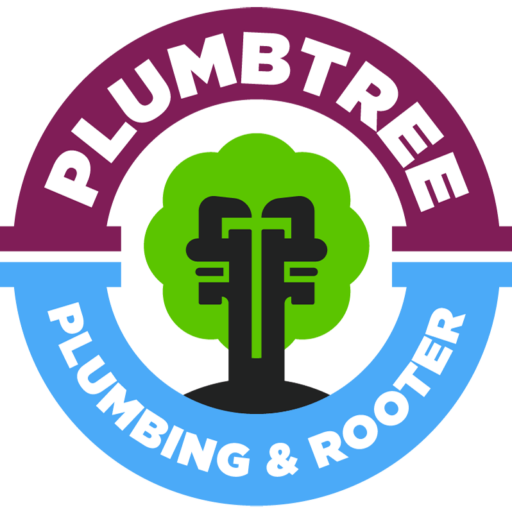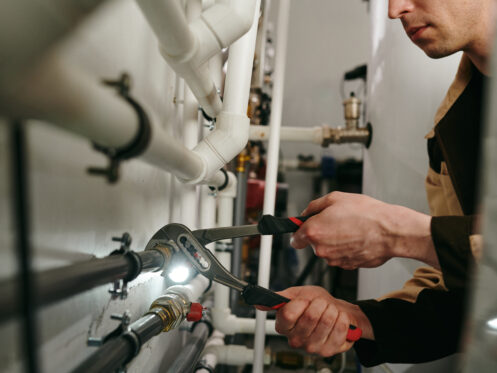If you need to replace any pipes inside or outside your house or are building a new home, you need to think carefully about what type of piping to use. There are a range of different types of pipes that can be used for water lines, drain lines and sewer lines. Each type has some distinct advantages as well as some drawbacks. In this article, we’ll discuss all of your different piping options and the pros and cons of each to help you make a more informed decision on which option is best for different plumbing applications.
Copper
Copper has been the most popular choice for hot and cold water pipes since the 1960s when the use of lead piping was phased out. Although copper is relatively soft compared to many other metals, copper pipes are still extremely durable and can potentially last for up to 100 years. Another advantage of copper is that it is highly resistant to corrosion so you won’t need to worry about your water lines rusting. Copper is also tolerant to heat. That means it can be used for both hot and cold water lines, unlike some other options that can only be used for cold water.
Despite having many advantages over other types of piping, there are also a few drawbacks to using copper. Although copper is durable and the pipes themselves aren’t all that prone to leaking, copper piping requires quite a few fittings since the pipes generally only come in lengths of up to 12 feet. This can be an issue since every fitting is a potential weak point.
Over time, the fittings can potentially become loose and leak to a fairly large leak developing. This is especially the case at all of the elbows where the pipes make a 90-degree turn. As the water hits the elbow and changes direction, quite a bit of turbulence is produced that can weaken the solder joint on the elbow and lead to it leaking.
All of the fittings can also be prone to getting damaged by high water pressure and starting to leak. High water pressure can also potentially cause copper piping to burst, which is why it cannot be used for a home’s main water line.
The biggest drawback to copper is the high cost, as it is much more expensive than all of the other approved options. This is not only because copper itself is expensive, but also because copper piping takes a long time to install since there are so many fittings and pieces of pipe that need to be soldered together.
Polyvinyl Chloride (PVC)
PVC piping is the preferred choice for the drain lines that connect to sinks, toilets, showers, etc. It is also safe to use for drinking water since it won’t ever corrode or give off any harmful chemicals. However, PVC is not heat resistant and can easily warp or get deformed if exposed to high temperatures, which means it can only be used for cold water pipes and not hot water. The building codes in some locations also don’t allow PVC to be used for any type of interior water lines since PVC pipes can be somewhat prone to leaking. PVC is also susceptible to damage from UV light so it can’t be used anywhere that the pipes could be exposed to sunlight.
PVC is also generally considered the best choice for certain types of underground pipes, specifically main sewer lines and sewer cleanouts that provide access to the sewer line. Some homes also use PVC for the main underground water line, but this is something most plumbers would recommend against. It is also commonly used for the vertical plumbing stack in a home. This stack sticks up through the roof so that air can get into the plumbing system and then extends down through the home and connects to the main sewer line.
One major advantage of PVC is that it is quite cheap and much easier to install than some other options. It is also resistant to corrosion and can withstand high water pressure without being damaged, unlike copper. PVC may crack over time if exposed to UV rays.
Chlorinated Polyvinyl Chloride (C-PVC)
C-PVC is similar to standard PVC except that it has a much higher chlorine content. This makes it stronger and more durable. It also prevents the pipes from being damaged by high temperatures, which is why C-PVC can be used for both interior hot and cold water lines as well as main water lines. It is also more flexible than standard PVC, which makes it a great choice for underground water and sewer lines. C-PVC can also withstand sunlight without being damaged, unlike standard PVC.
C-PVC provides all of the same advantages as standard PVC in terms of being easy to install, relatively inexpensive and having quite a long lifespan. It is slightly more expensive than standard PVC, but still lots cheaper than copper. The biggest drawback is that the manufacturing process used to make C-PVC is even more polluting than standard PVC, which means it is not considered an environmentally friendly option.
High-Density Polyethylene (HDPE)
While PVC and C-PVC aren’t necessarily bad options, many plumbers consider HDPE piping the preferred choice for underground water mains. However, building codes don’t allow HDPE to be used for any interior water lines.
HDPE is non-corrosive and safe to use for drinking water. However, the main reason it is a great choice for water mains is that it is extremely strong, durable and highly flexible. This means that it can withstand shifting soil without breaking, unlike PVC. The flexibility also makes it an ideal choice for earthquake-prone areas since it is less likely to break compared to any other option. The only real drawback to HDPE is that it is somewhat expensive, which is why some people still opt for PVC or C-PVC instead.
Cross-Linked Polyethylene (PEX)
PEX is one of the newest piping options and has quickly become an extremely popular alternative to copper for interior hot and cold water lines. PEX piping is also safe for use underground as long as it is insulated and buried below the frost line, but most plumbers would say you’re better to use HDPE for your main water line and then PEX inside.
PEX piping is extremely flexible, and all of the interior water lines can be installed using just a few fittings. This is part of the reason why many people prefer it over copper since fewer places could fail and start leaking. The fact that PEX piping doesn’t require many fittings and comes in long rolls makes it much quicker, easier and less expensive to install than any other option. PEX is also quite inexpensive and will cost far less than copper. Although frozen water lines aren’t a major concern in California, another advantage of PEX is that it can expand so the pipes won’t burst if they freeze like copper pipes will.
At Plumbtree Plumbing & Rooter, we specialize in plumbing installation and repiping and can help you determine which material will work best for your specific needs. Whether you need to replace your sewer line or want to upgrade your water lines, you can count on us to provide expert work and advice. For more information or to schedule any plumbing, sewer, drain or gas line service in the San Jose area, contact us today.

